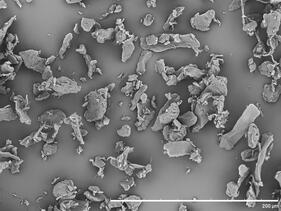Plant-Based Fibers in Plastics
Compounding with Plant Fibers
When you look around, there are tons of statements like 'Plastic-free', 'Reduce plastic consumption…', '… without plastics…' etc… While it is true, that unwise plastic production and usage lead to environmental problems and resource waste, it is equally true that this large group of materials is linked to technological progress and human civilization itself. Imagine a world without plastic packaging. How would it be possible to transport and store food for agglomerated human populations like cities? How would you store and heat your home cooked lunch in the office? There are alternatives, and they have their space. Apart from them, a 'plastic-free' world is nonsense.
It is difficult, that our societal trend creates a kind of plastic phobia, when in fact more bright minds are needed to change the raw material basis, recycling streams and formulation of plastics.
One of the first and popular steps is, to include plant-based fillers and create composite materials with high bio-based content. In terms of mechanical properties, it is sometimes possible to substitute glass fibers or mineral fillers like talcum. Taking into account the CO2 storage of plants, it is even possible to use plastic composites as carbon sinks. Fine ground and white cellulose fibers can still store around 1t net CO2 per ton of product. For wood, the storage is even higher, as the pulping process is missing. In the light of those functional and environmental-friendly potential, it is no wonder that more materials, applications and recycling options are tested. However, using plant-based fibers in plastic compounds, comes with certain challenges:
1. Thermal stability, which is limited to 200-220 °C, excluding many technical polymer matrices.
2. Fiber-matrix interaction of polar plant polymers and non-polar plastic matrices.
3. Dispersion of plant fibers in the plastic resin, balancing between good mixing and lowest possible mechanical and thermal stress.
4. Residual moisture, which needs to be vented or, in case of bioplastics, removed before compounding.
5. Feeding of longer fibers into an extruder, as the material is not free flowing and has a fluffy appearance.
Some of those hurdles are handled quite well by most compounders, while others offer an overwhelming field of possibilities, especially when bioplastics come into play as additional material class, which has great potential in synergies with plant fibers. We have conducted a study about cellulose and EFC products in PLA with some interesting findings.
Fibers or Particles? About Shape, Structure and Surface Energy
Before we go into details of study results, some remarks about structure function relation. Often, you read about natural fiber composites, where ‘fiber’ indicates an aspect ratio, describing the defined relation between length and width. In the case of short fiber composites (µm - mm scale), this is only true for cellulose fibers (CF) with average fiber lengths of >100µm and a naturally grown width of 20-30µm (picture CF 1). Short cellulose grades like CF 3 and even the longer CF 2 are less fibrous but more particle shaped. The same accounts for wood powders (WP), where the lignin and hemicelluloses glue together the cellulose strands giving the product particle shapes, no matter if you look at fines (d50 ~30µm) or coarser fractions (d50 ~400µm).
Studying the pictures, it seems obvious, that some of the challenges mentioned above, come with the shape of the plant-based filler. Additionally, the impact of fiber fillers are different depending on their shape. Provided a sufficient dispersion, longer fibers like CF 1 give better mechanical reinforcements than fines (picture CF 3).



In the study, conducted by Fraunhofer Institute IVV & UMSICHT, two of our products, a fine cellulose (CF 2 d50 ~60µm) and EFC (d50 ~70µm) were compounded with commercially available PLA, injection molded into standard bone shaped sample bodies and put through mechanical testing (Tab. 1).
Sample | E-modulus [MPa] | Tensile strength [MPa] | Tear strength [MPa] | Elongation at break [%] |
|---|---|---|---|---|
PLA + Coupling agent + 30% CF 2 | 5530 ± 86.7 | 69.4 ± 0.56 | 69.3 ± 0.62 | 1.8 ± 0.10 |
PLA + 30% CF 2 | 5200 ± 185 | 68.2 ± 0.76 | 68.1 ± 0.73 | 1.8 ± 0.12 |
PLA + 15% CF 2 | 4290 ± 101 | 66.1 ± 0.16 | 61.9 ± 0.41 | 2.8 ± 0.17 |
PLA + 30% EFC | 6110 ± 154 | 74.2 ± 0.38 | 74.0 ± 0.27 | 1.9 ± 0.09 |
PLA reference | 3580 ± 27.6 | 74.2 ± 0.32 | 61.3 ± 0.67 | 5.8 ± 0.33 |
Tab. 1: Mechanical testing


As expected, we see a higher stiffness with increasing filler content, but looking at the fillers' shapes, the significant better values of EFC filler compared to pure cellulose come as a surprise. Our theory is, that besides shape and dispersability, the surface energy plays a pivotal role. A quick dive into chemistry: On a basic level, surface energy can be estimated in wetting experiments. The types of intermolecular forces holding the material bulk together define the energy of a substance. Polar interactions like hydrogen bonding are stronger than van der Waals forces, hence a polar surface is a higher energy substrate than a non polar surface. A higher energy liquid would not readily wet a low energy surface.
Having this in mind, it seems that the EFC, as it is a chemically purified wood product, has lower surface energy than standard wood or cellulose grades, where the number of free hydroxyl groups on the surface should be higher.
Hence, the EFC production process mimics an alkali treatment, which is known to cause stronger interactions between polar fibers and non polar matrices. In our case, the effect is clearly better than the addition of a coupling agent, which in fact showed nearly no improvement.
If the results are interesting for your project, we are readily available to discuss details and further findings about biodegradation.









